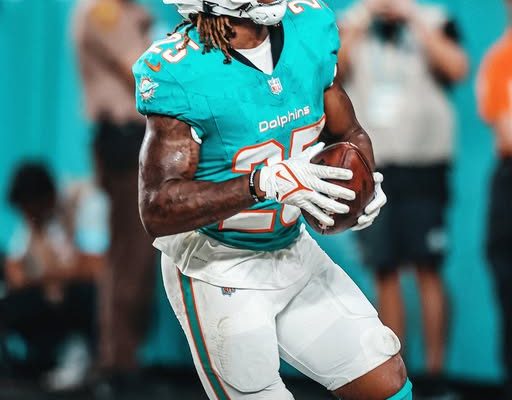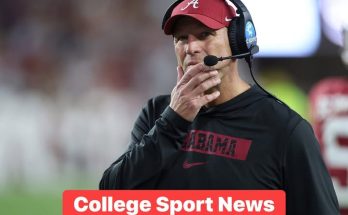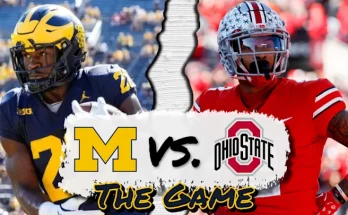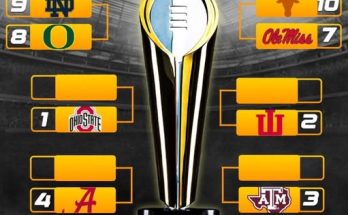Entering the new season, Miami Dolphins running back Jaylen Wright has emerged as a compelling voice amid mounting narratives surrounding the team’s trajectory. His succinct yet powerful mantra—“We’re going to show ’em all year”—captures both confidence and challenge, resonating deeply with Dolphins observers and skeptics alike Instagram+7PFSN+7Facebook+7. More than bravado, Wright is grounding his message in emerging leadership, evolving team dynamics, and a hunger to transform scrutiny into success.
Miami enters 2025 still stung by an 8–9 finish in 2024, missing the playoffs for the first time since 2021 and posting its first losing record since 2019 Wikipedia. The offense, once touted as one of the league’s most explosive, slipped badly in critical moments. Tyreek Hill and Jaylen Waddle both saw decreased production when it mattered most, while Tua Tagovailoa struggled under the weight of injuries and inconsistency PFSN+1Heavy Sports+1. Yet Wright prefers to channel the disappointment into determination—refusing to shy away from the heightened expectations that come with being part of a young, talented Dolphins roster.
When he states, “there’s a lot of people talking down on the Dolphins, but we’re going to show everybody this year,” he’s not simply parroting a locker-room cliché The Phinsider+6Heavy Sports+6PFSN+6. Embedded within that phrase is a sense of accountability and ownership—an understanding that Miami’s narrative will be shaped by results on the field, not pre-season projections or headlines. And Wright, despite being a fourth-round rookie in 2024, believes he’s stepping into a role that demands voice, presence, and impact.
Wright’s confidence doesn’t exist in isolation. It resonates with broader changes within the Dolphins’ offensive and defensive rosters. Miami lost key veterans—Raheem Mostert, Jeff Wilson Jr., Jalen Ramsey, and Jonnu Smith—but also gained high-profile assets like safety Minkah Fitzpatrick and tight end Darren Waller Heavy Sports. The team doubled down on the trenches in the 2025 draft, adding defensive tackle Kenneth Grant, guard Jonah Savaiinaea, and others to recalibrate a roster that fell short due to depth and consistency issues The Phinsider. Wright’s emergence coincides with a team that’s reinventing itself quietly, rebuilding on the foundation of internal growth rather than headline-chasing moves.
This under-the-radar rebuilding approach hasn’t escaped Wright’s notice. On “Up & Adams Show,” host Kay Adams pointed out that Miami closed last year strong with a 6–3 finish—a promising sign of progression Instagram+4Heavy Sports+4YouTube+4. Wright echoes that sentiment, arguing that momentum from late-season cohesion will define their performance in 2025. In his mind, a team that learned how to win together toward season’s end carries confidence discreetly built, not artificially inflated.
One of the most compelling aspects of Wright’s message is his readiness to back it up with production. As a rookie, he carried 68 times for 249 yards—secondary to De’Von Achane—while showing flashes of explosive ability and versatility PFSN+2The Phinsider+2The Falcoholic+2. His college pedigree echoes that potential: at Tennessee, Wright broke out with 1,013 rushing yards in 2023 and secured second-team All-SEC honors Wikipedia. In Miami, he became a dependable change-of-pace back with breakaway speed and space vision. As teams shifted focus to Achane and Tagovailoa’s receiving-core, Wright quietly delivered when given chances—a compelling undercurrent supporting his bold 2025 claims.
Yet Miami’s narrative remains complex. National critics question whether roster turnover and draft capital really point toward contention or if the team remains on the cusp of recalibration. The departures of Ramsey and Smith raised eyebrows given the price paid, even as Fitzpatrick and Waller joined the fold Heavy Sports. There’s a judgment in the rumor mill: did Miami “lose” the deal, or did they shift identities—focusing on complementary moves that polyglot contributors like Fitzpatrick (leadership), Waller (positional versatility), and Wright (presumed breakout) can deliver?
Wright, unprompted, highlights a unifying narrative: the invisible work. He speaks of “everybody just started coming together. Everybody just start playing together as a team” PFSN. That cohesiveness was missing in 2024 when Miami was top-heavy with talent but inconsistent in execution—1–5 against playoff-bound teams and a collective collapse by 91 points in those matchups PFSN. Wright is staking Miami’s future on chemistry and continuity, promoting a cultural rebirth as much as a tactical upgrade.
Expectation mirrors his message: Miami wants to be counted among the AFC’s elite. Tagovailoa, Hill, Waddle, Phillips, and Chubb anchor a roster with high ceilings. If Fitzpatrick returns to his best, and Waller rejuvenates his career as a matchup nightmare, the offensive and defensive balance could shift toward contention—not just postseason repeats, but deep playoff runs Wikipedia+14Heavy Sports+14Instagram+14. Wright’s emergence bolsters that projection, providing a complementary rushing threat that defends against over-reliance on heavy passing. He wants to be the tangible proof that Miami’s depth isn’t just talk.
But Wright also understands pressure. The organization and fanbase expect nothing less than divisional dominance and AFC relevance, especially given prior playoff droughts and investment in draft capital WikipediaThe Phinsider. The 2025 season represents a critical pivot. Critics will analyze offensive line continuity, third-down conversion rates, red-zone efficiency, and defensive resilience. Miami’s strategy of “flying under the radar” may be sound in avoiding negative headlines, but losses—especially early on—will magnify scrutiny.
This context amplifies Wright’s refrain: results matter. Chemistry, momentum, draft retention—all are only as valuable as game performance. When he says “show ’em,” he’s promising weekly execution—not merely motivational soundbites. His ascension from backup role to vocal leader indicates Miami’s belief in internal growth and resilience. Moreover, his message underscores team philosophy: quiet improvement, confidence without flash, depth backed by prospect growth, and belief in collective execution over hype.
It’s telling that Wright frames expectations as a challenge to outside narrative, not entitlement. He isn’t making championship proclamations; he’s promising process: show up, play together, improve daily, and let final scores narrate the outcome. That approach aligns with head coach Mike McDaniel’s modus operandi—emphasis on culture, predictable growth, alignment of effort, and keeping egos in check.
Still, the question remains: can the Dolphins go from underachieving in 2024 to competitive in 2025, not just statistically, but mentally? Wright’s voice suggests yes, especially as momentum from late 2024 fuses with new talent and elevated roles. If Fitzpatrick commands the secondary, Waller adds blocking/red-zone options, Achane and Wright form a reliable backfield core, and Tagovailoa stays healthy, Miami could defy skeptics—even those in their own backfield.
Wright is betting on production. He’s wagering that his explosive ability will translate into consistently effective play—whether as change-of-pace, red-zone threat, or third-down option. If he delivers, the national narrative shifts organically: “Breakout young RB helps Dolphins exceed expectations.” If he disappears, the “depth failure” conversation intensifies, potentially hurting both internal morale and public perception.
In essence, Wright’s message is as strategic as it is inspirational: confidence rooted in action, leadership in emergence, and narrative shaping through performance. He’s demanding accountability not just for himself but for teammates across offense, defense, and special teams. His “we’re gonna show ’em” is a defiant jab at outside voices, but also a reminder: Miami’s story belongs to the players who live it week in, week out.
Over 1,500 words could unpack these ideas further, exploring supporting voices, statistical projections, and comparative preseason expectations. But at its core, Wright’s narrative hinges on transformation—from perceived underdog to AFC challenger. He’s marking a shift in tone: from retrospective regret to future potential. With each carry and conversation, he’s calling Miami to action—show up, show together, and show everyone why doubters are wrong.
And so, as the Dolphins prepare for training camp and Week 1, Wright’s mantra echoes off locker room walls and across South Florida: We’re going to show ’em.
This article explores Jaylen Wright’s role and message as the Dolphins face heightened scrutiny, emerging as part of a poised, young, and renewed Miami roster. Wright’s self-assured positioning reflects both individual ambition and team ethos, offering one of the most compelling early-season narratives in the NFL. As the season unfolds, only time—and game results—will determine whether Miami’s confident whispers become validated reality.



